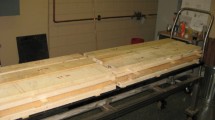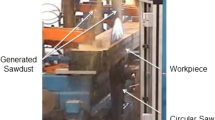Abstract
The study evaluated airborne dust emission (0.1–10 µm) during the routing operation of Rubberwood (Hevea brasiliensis) in the furniture industry in South East Asia. It was found that the average chip thickness of 0.1 mm and wood moisture content of 12–14% minimized dust emission, while the cutting tool rake angle had little influence on dust emission. The study shows that adverse economic implications due to health hazards posed by airborne dust emissions during wood machining can be reduced by manipulating the average chip thickness and work-piece moisture content.
Similar content being viewed by others
References
Anon (2008) Health Hazards among Woodworking Industry Workers – A Review. International Furniture Research Group (IFRG), Report No. 6/08, Serdang, Selangor
Box GEP, Hunter WG, Hunter JS (1978) Statistics for Experimenters. John Wiley & Sons, New York
Hong LT, Sim HC (1999) Rubberwood – Processing and Utlization. Malayan Forest Record No. 39, Forest Research Institute of Malaysia, Kepong
Koch P (1964) Wood Machining Processes. The Ronald Press, New York
Nylander LA, Dement JM (1993) Carconogenic effects of wood dust: review and discussion. Am J Ind Medicine 24:619–647
Palmqvist J, Gustafsson SI (1999) Emission of dust in planing and milling of wood. Holz Roh- Werkst 57:164–170
Ratnasingam J (2004) Economic of the rubberwood processing industry – a south east asian perspective. Asian Timber 23(2):16–18
Ratnasingam J, Scholz F (2007) Characterizing surface defects in machine-planing of rubberwood (Hevea brasiliensis). Holz Roh- Werkst 65:325–327
Ratnasingam J, Scholz F (2008) Yield studies of Rubberwood lumber during rough milling operation. Holz Roh- Werkst 66:467–468
Ratnasingam J (2008) Rubberwood dust: its health hazards. Asian Timber 27(1):14–16
Author information
Authors and Affiliations
Corresponding author
Rights and permissions
About this article
Cite this article
Ratnasingam, J., Scholz, F. & Natthondan, V. Minimizing dust emission during routing operation of rubberwood . Eur. J. Wood Prod. 67, 363–364 (2009). https://doi.org/10.1007/s00107-009-0328-y
Received:
Published:
Issue Date:
DOI: https://doi.org/10.1007/s00107-009-0328-y




